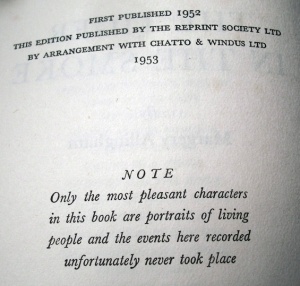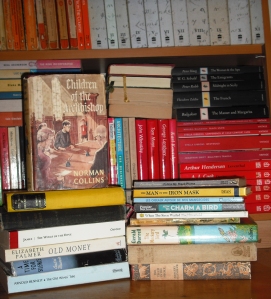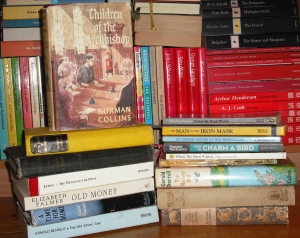Well, when I say that, I really mean that I fleetingly considered not going to the Trinity Book Sale this year as I still have the inevitable pile of un-read books. However, as I managed to miss last year’s event due to its move away from an end of the week spot, I thought that I would make the effort and toddle along. The more I considered the matter, the less I wanted to risk missing any book bargains, especially as I am an aficionado of the half–price last day. Previously held on a Saturday, but now a Thursday, it is my ultimate book bargain pleasure.
This year, my final tally was seven volumes for a modest six euro; though two of the books were for The Bookworm, (I also blame her for drawing another couple of titles to my attention). As is usual at book sales, I felt that I could easily have gone along picking up books left, right and centre. I have done this at a library sale before now and virtually needed a fork lift truck to carry my purchases home. On this occasion, only a carrier bag was required to lift the spoils.
As you can see from the photos shown here, I brought home an interesting mix of fiction, biography and classic works. The Bookworm sneaked in an extra visit on the previous day, so here is our combined haul of reading matter for the next wee while. I was particularly struck by the little book, Miss Brown’s Hospital by Francesca French (1954). This is the story of Dame Edith Mary Brown who was the founder of Ludhiana Medical College in Eastern Punjab. I had not heard of her before, but Miss Brown apparently had ‘many claims to distinction: as scholar, doctor, educationalist and pioneer’. She was a graduate of Girton College, Cambridge, studied for a medical diploma in Scotland and obtained her MD in Brussels.
Edith Brown was also devoutly religious and ‘at the back of her mind was the unswerving determination that in applying her medical skill to the benefit of mankind she must combine it with the great emancipating power of the Gospel of Jesus Christ’. She decided to focus both her medical skills and her spirituality upon the women of India in the role of a medical mission. Her appointment in 1891 to the medical mission at Ludhiana gave her the opportunity she sought. This led to her establishing a medical training centre for Indian women. I hope to return to Miss, or rather Dr Brown in a future blog post when I have had a chance to read the book properly and perhaps also to delve a little more into the period and the location.
I was particularly pleased to discover the book on Sir Christopher Hatton (Eric St. John Brooks) as I have been having an extended Tudor-related reading period. This ties in quite nicely with a few other books that I have read over the past few months (some previously featured on this blog). Christopher Hatton was one of Elizabeth I’s favourites, a statesman and councillor who held the office of Lord Chancellor. As the lives of the courtiers in Elizabeth’s hotbed of political scheming were inextricably entwined, Hatton has popped up in my historical reading several times. This book, first published in 1946 was apparently an attempt to present a balanced view of Hatton’s life and achievements. The blurb claims that ‘Hatton’s part in the history of his times has been largely misunderstood’. It may be that later scholarship has superseded Brook’s study, so I will check to see if anything has been published on Hatton since then. Anyway, after enjoying an account of Sir Walter Raleigh’s life recently (Margaret Irwin), I shall look forward to reading it. No doubt I will meet up with Raleigh again as I read about Hatton, as I note that he merits several entries in the index.
Now, I am off to decide which of my Trinity Book Sale acquisitions to tackle first!















You must be logged in to post a comment.